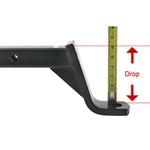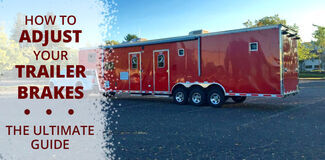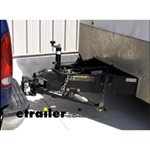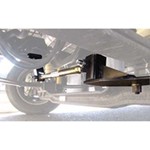The Basics: Firestone Air-Spring Kits
Variable load-carrying capability Adjustable spring strength User-friendly height control
Custom Fit Vehicle Suspension

Front Application
Benefits:
Increases rear-wheel traction, thereby improving steering and vehicle balance Reduces front tire wear Levels headlights, increasing visibility Enhances braking and handling, even in adverse road conditions Can be adjusted to accommodate varying loads
Reduces wear on front springs, as well as shocks Lessens front-vehicle sag
Prevents bottoming out Provides smoother ride Decreases vehicle roll that results from towing trailers
Types of Kits Used in Front Applications:
Coil-Rite Air Helper Springs
Adjustable air spring installed inside existing coil spring When properly inflated, the springs provide additional support for the existing suspension Adjustable pressure level (to accommodate various load sizes) Recommended pressure: 5 psi - 35 psi
Constructed of durable polyurethane
Weight capacity: 500 lbs - 1000 lbs Typically found on: Pickups P-30 Motor homes SUVs Cars
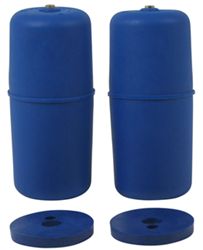
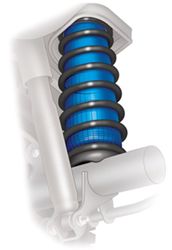
Ride-Rite Air Helper Springs
Uniquely designed, convoluted springs installed between the axle and the vehicle frame Provides additional support for the existing suspension The more weight compressing the convoluted springs, the stronger the springs become Adjustable pressure level (to accommodate various load sizes) Recommended pressure: 5 psi - 100 psi
Weight capacity: 3,200 lbs - 5,000 lbs Typically found on: Pickups Class A, B and C motor homes Vans Commercial vehicles
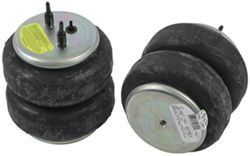
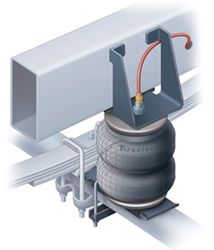
Level-Rite Air Helper Springs and Shock Absorber
Air spring paired with high-performance shock absorber Reversible-sleeve air spring combined with Bilstein monotube shock absorber Improves vehicle control and stability Reduces wear and sagging on existing torsion bars Absorbs road shock Allows you to adjust front-ground clearance for your vehicle Adjustable pressure level (to accommodate various load sizes) Recommended pressure: 10 psi - 100 psi Can be quickly inflated or deflated
Replaces original shocks on vehicle
Typically found on: Pickups
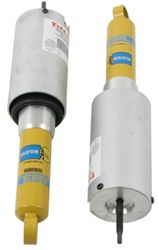
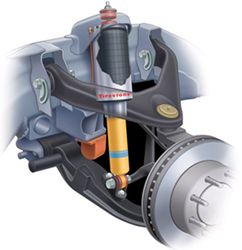
Rear Application
Benefits:
Increases front wheel traction, improving steering and vehicle balance Levels headlights, thereby increasing visibility Enhances braking and handling, even in adverse road conditions Can be adjusted to accommodate varying loads Reduces rear-tire wear
Reduces rear vehicle sag Provides an additional contact point for suspension system, distributing the load evenly
Enhances the ride of the vehicle Prevents bottoming out Adjustable springs can be individually inflated to balance out and redistribute uneven vehicle loads
Types of Kits Used in Rear Applications:
Ride-Rite Air Helper Springs
Uniquely designed, convoluted springs installed between the axle and the vehicle frame Provides additional support for the existing suspension The more weight compressing the convoluted springs, the stronger the springs become Adjustable pressure level (to accommodate various load sizes) Recommended pressure: 5 psi - 100 psi
Weight capacity: 3,200 lbs - 5,000 lbs Typically found on: Pickups Class A, B and C motor homes Vans Commercial vehicles


Sport-Rite Kits
Uses tapered, conical-shaped air springs installed between the axle and vehicle frame Tapered design creates an extremely smooth, stable ride Result of inverted sleeve design (that creates a rolling action as the vehicle rides up and down)
Provides additional support for the existing suspension Adjustable pressure level Recommended pressure: 10 psi - 100 psi
Weight capacity: 1,000 - 3,000 lbs Typically found on: 1/2-Ton pick-ups 1/2- and 3/4-Ton vans SUVs Mini-trucks
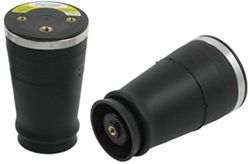

Coil-Rite Air Helper Springs
Adjustable air spring installed inside existing coil spring When properly inflated, the springs provide additional support for the existing suspension Adjustable pressure level (to accommodate various load sizes) Recommended pressure: 5 psi - 35 psi
Constructed of durable polyurethane
Weight capacity: 500 lbs - 1000 lbs Typically found on: Pickups P-30 Motor homes SUVs Cars


Air Spring Kit Tips:
Each air-spring kit comes with vehicle-specific brackets, hardware to complete an installation and all parts necessary for manual inflation. Tools required for installation will vary from kit to kit
Air-Helper spring kits will not increase the overall weight-carrying capacity of the vehicle The weight rating stated for each air-spring kit is the weight range the spring kit is designed to support, not the weight the vehicle can support
How to determine the appropriate amount of air pressure for the springs based on load weight and location Record the measurements from the ground to the top of the wheel well for all 4 wheels before you load the vehicle Load your vehicle Add air pressure to the springs until the wheel-well height returns to within a 1/2" of the original, unloaded height This will be an approximate place to start
Take your vehicle for a drive and inflate or deflate the springs as needed to find a smooth, comfortable ride for your load
When the vehicle is not loaded, leave at least 5 psi in each spring to prevent damage
See More on Firestone Suspension Products
Departments
Towing
- Trailer Hitch
- Fifth Wheel
- Gooseneck
- Towing a Vehicle
- Front Hitch
- RV Hitch
- ATV Hitch
- HD Truck Hitch
- Vehicle Wiring
- Brake Controller
- Ball Mounts
- Weight Distribution
Sports and Recreation
Trailer Parts
- Utility Trailer
- Boat Trailer
- Landscape Trailer
- Enclosed Trailer
- 5th/Camper Trailer
- Car Hauler
- Horse Trailer
Vehicle
Contact & Help

What our customers are saying:
"Very helpful/friendly Customer Service. Competitive Pricing. Shipping was Fast."
John
Mankato, MN

















